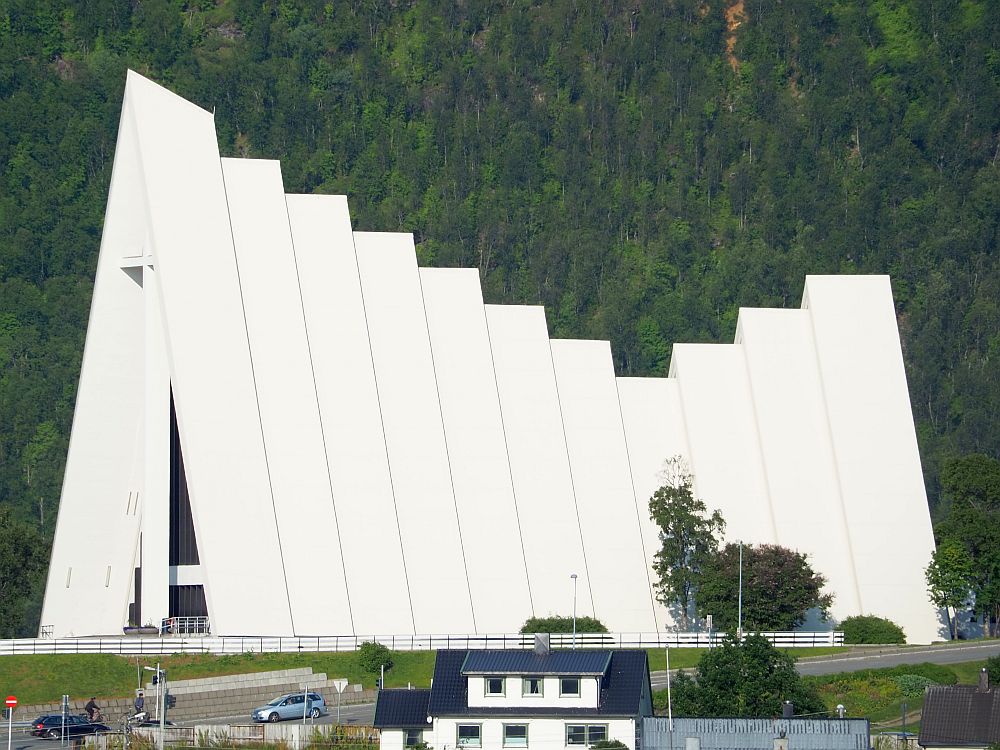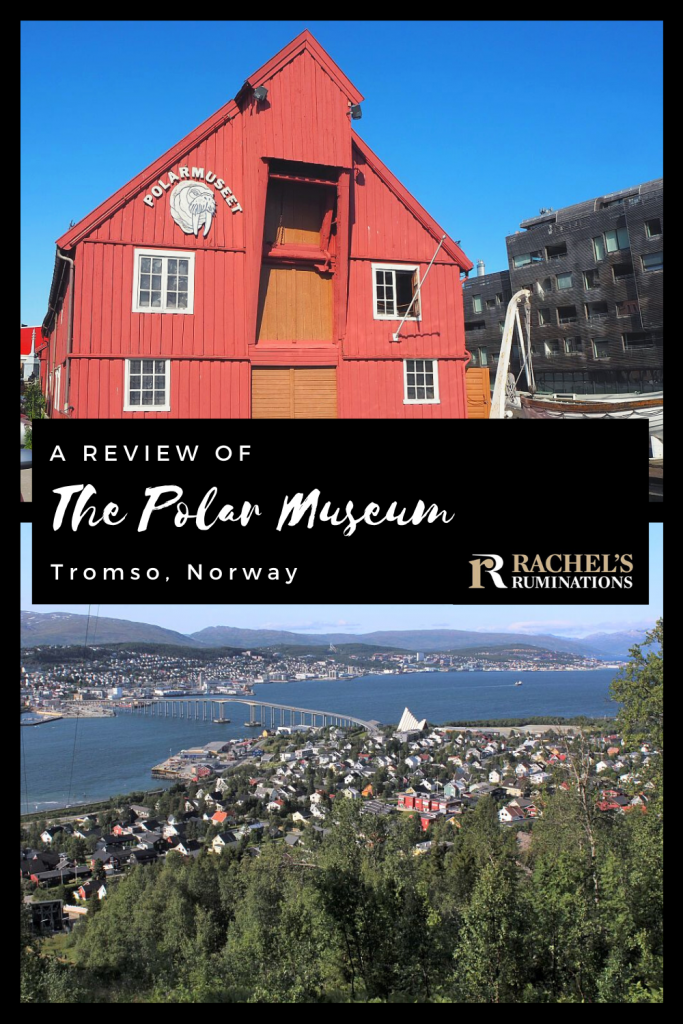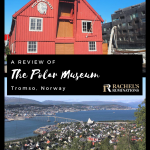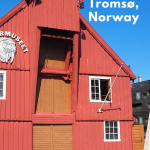The Polar Museum, Tromso, Norway
The picturesque harbor town of Tromso (spelled Tromsø in Norwegian), lies more than 300 kilometers / 200 miles above the Arctic Circle. It has a history of serving as a jumping-off point for varous polar activities like trapping, hunting and fishing, as well as polar exploration. Nowadays, it is home to a fascinating little place called the Polar Museum. Covering a range of topics, the museum moves visitors through the history – and the dangers – of life in the Arctic.

Disclosure: This article contains affiliate links. If you make a booking through one of the links, I will receive a cut of what you spend. This will not affect your price.
We arrived in Tromsø on a Hurtigruten ship one day in late July. These ships steam up and down the coast in about a week each way, stopping at every port to deliver mail and cargo. Locals use the ships to travel between stops, while tourists like us enjoy the trip as a cruise. I wrote a detailed review of it soon after.

A stop in Tromsø
Anyway, our stop in Tromso was several hours long, so we could get off the ship and explore a little. My husband went off to take a cable car up the mountain that forms the backdrop for the town. I chose to visit the Polar Museum. To get there I walked along the harborside, past an array of prettily painted wooden former warehouses.

The museum is housed in what used to be a warehouse, built in 1830, painted bright red. Inside is a warren of rooms, ten in all, each looking at a different piece of life in the Arctic Circle.

I should add a warning here, before I move on. If you are upset by the sight of furs or taxidermy animals, I’d suggest you go read something else. The story of humans in the Arctic has always been about hunting, trapping and fishing, and it’s on display throughout the museum – and my photos. You’ll see taxidermy animals, skeletons, fur coats, skins, and so on.
If you’d rather, you could read pretty much any of my articles about Norway, Sweden or Finland instead and only rarely come across any dead animals.
To book accommodations in Tromso, just zoom in on the map below:
Hunting and trapping at the Polar Museum in Tromso
Most of the ground floor rooms address hunting and trapping. In the 19th century, winter expeditions to Svalbard, an island group in the far north, mostly focused on walruses, but also took seals and reindeer. In the early 20th century, attention turned to Arctic foxes and polar bears on the yearly expeditions.

These rooms, then, start with life-sized dioramas showing what life would have been like hunting, trapping and living in primitive cabins in the far north in winter. One of the rooms focuses on seals and the fur trade. It tells about particular fur trappers and hunters, showing some of the possessions they carried with them.

We learn about the “pioneers” traveling to Svalbard and how they lived, along with information about reindeer and Arctic fox hunting.
We explore Svalbard itself, and how the Dutch, the English and the Danish/Norwegians used it for hunting walruses and whales as early as the 17th century. Displays show archeological finds from their presence on Svalbard.

Next, the story turns back to looking at seal hunting, and how techniques evolved, boats improved, and what life on a sealing boat was like, all the way up to the 1970s, when restrictions began to be imposed on the seal trade.

One of the upstairs rooms tells the stories of two particular winter trappers. Henry Rudi, oddly from today’s point of view, became a popular hero in his time. Why? Because he killed 713 polar bears over the course of 27 winters. Wanny Woldstad was an accomplished marksman (markswoman?) and taxi driver (Tromsø’s first taxi, in the 1920s). She became the first woman trapper on Svalbard, hunting for several winter seasons in the 1930s.
You might also enjoy these articles:
Polar expeditions
For the most part, attention shifts to polar exploration in the upstairs rooms. One room looks at aircraft that were used to explore the North Pole.
Another room covers Roald Amundsen in detail: how he studied the magnetic North Pole on a series of expeditions through the 1910s and 20s, including several attempts to reach the North Pole by air.
Amundsen’s famous trip on the Fram in 1911 is unusual because the goal changed at the last minute from the North Pole to the South Pole. Amundsen hoped to reach it before the British expedition happening at the same time, led by Robert Scott. Amundsen won the race, and Scott and his party died on the way back to their base camp.

The Fram’s history-making expedition
Speaking of the Fram, the last room upstairs relates the dramatic story of the Fram‘s first expedition, meant to reach the North Pole, but very slowly. The idea was to follow a theory by Fritjof Nansen. He believed, based on some wreckage from Siberia that turned up far away in Greenland, that the same could be done with a boat. It could go as far north as possible, become icebound, and the ice would carry it over the course of a few years from the east to the west, right across the North Pole.
This was a pretty daring idea, as you can imagine, and took years of preparation. The Fram was built for purpose to be able to withstand the pressure that the ice would place on it. It launched in 1892. The museum tells the Fram’s exciting story in quite a bit of detail, from the expedition’s start in June, 1893, to its completion in August 1896.
Sailing north, the crew anchored to an ice floe and settled in. They spent the time working on various scientific measurements of the ocean, the ice, the wildlife, and so on.

An exciting story from the first Fram expedition
The boat seemed to stop making headway after more than a year, in September 1894. Two of the crew members, Hjalmar Johansen and Fridtjof Nansen, set off to reach the North Pole anyway, bringing dogs, dogsleds, kayaks and other supplies from the ship. Because of difficult ice and weather conditions, they gave up by April 1895 a few hundred kilometers short of the pole, and headed back.
Eventually, with their provisions used up and all of their dogs dead, they had to spend the winter in a hut they built themselves on Franz Josef Land, a cluster of islands that is now part of Russia. They left it in May 1896. In June, they found a British expedition camp, allowing them to make their way home to Norway. This meant that they wandered the Arctic (or holed up in their homemade hut) for more than a year!

The Fram, meanwhile, had spent in total about three years drifting across the Arctic but missing the North Pole. It arrived back in Svalbard a few months after these two incredible survivors.
My review of the Polar Museum, Tromso
This museum is well-presented and well-lit, with signs in Norwegian and English. It retells so many exciting stories, especially in the rooms looking at polar exploration, that I think that might be my only complaint: I only had a short time and could have used more. If you ever find yourself in Tromsø, make sure to put aside several hours to study the exhibits in more detail than I did.
If you’re there with children, though, your visit is likely to be shorter. The stories are good, but many are told in print, next to the artifacts involved. With children, you’ll need to do some quick skimming just to explain what the items are about and move on.
What I’d suggest is to stay several days in Tromso. There are lots of activities available: snowshoeing, Northern Lights viewing, dogsledding, kayaking, whale-watching, to name a few. Here’s a link you can use to a whole list of activities in or near Tromso.
If you arrive via one of the Hurtigruten ships, you can split your reservation. In other words, get off for a few days and then get back on a subsequent ship – they pass every day – to continue your trip northward or southward.
Other things to see and do in Tromso
The old part of town
If you don’t have time for anything else, at least take a quick walk through the old part of town. When I say “old” I mean mostly the first half of the 19th century. The buildings – shops on the main shopping street, as well as houses in the residential streets – are wooden and painted brightly, and there are two pretty little churches to see too.

Polaria
Once you visit the Polar Museum, take a quick walk along the water’s edge away from the big bridge that links the two sides of the city. Soon you’ll see a very odd building. It looks like a bunch of big white blocks that have been knocked over. This is Polaria, an Arctic aquarium, including a seal pool. I didn’t see it because I was out of time, but I’m sure it would be very child-friendly.

Polstjerna
Just before you reach Polaria, you’ll pass the Polstjerna, a typical fishing boat, inside a glass building. When I visited it was closed. Apparently it still is, but you can see it well from the pier nest to it through the glass. It must be a hard life to be a fisherman in the far north.

Tromso Cathedral
The city of Tromso extends on both sides of a waterway called Tromsøysundet. A building that stands out on the other side is the large white Lutheran Tromso Cathedral. I didn’t see it except from a distance but I heard that it is quite pretty inside as well.

Fjellheisen cable car
Also on the other side of the water is the attraction my husband chose: a cable car ride up a nearby mountain above the city. The ride takes only four minutes and rises over 400 meters above sea level. At the top you can walk further uphill for perhaps an hour to see views in other directions.

Magic Ice Bar
Right next to where the Hurtigruten ship moors is the Magic Ice Bar. I went in just briefly because I was alone. It just felt a bit strange to go into a bar all by myself. At the entrance I received a poncho and gloves before entering the bar area itself.
Inside, everything is made of ice: the bar, the tables, the chairs, the walls. Even the glass for your drink (included in the price) is ice. The walls have a range of artwork on them – or, rather, in them – in the form of etched-out pictures. Here and there are ice statues on ice pedestals. All of it is dramatically-lit, predominantly in blue.

It’s cold in there, of course. It’s a strange sensation to drink from an icy glass, but the alcohol definitely feels warm as it goes down. Being by myself in what turned out to be an empty bar, I ended up have a short chat with the bartender and leaving. It would be fun with a group of friends.
Visiting the Polar Museum and Tromso
Tromso is very far north in Norway. I suspect that the most common ways to get there are by flying or, as we did, arriving on a Hurtigruten cruise or another boat.
The Polar Museum in Tromso is open daily 11:00-17:00 in September-May and 11:00-18:00 in June-August. Admission: Adults NOK 70 (€6.45 / $7.25); Children 7-18 NOK 35 (€3.20 / $3.60). Website.
Polaria is open daily 10:00-16:00. Admission: Adults NOK 175 (€16 / $18); children 3-16 NOK 80 (€7.35 / $8.25), one child with one adult NOK 200 (€18.35 / $20.50). Website.
Polsternja is closed for renovation and it’s unclear when it will open again. Website.
Tromso Cathedral is open Monday-Saturday 11:00-17:00 and Sunday 13:00-17:00. Website.
Fjellheisen Cable Car is open daily, Monday-Thursday 11:00-19:00 and Friday-Sunday 11:00-23:00. Admission: Adults NOK 218.50 (€20 / $22.50) round-trip, NOK 142 (€13 / $14.50) one-way; children 3-15 NOK 114 (€10.50 / $11.75) round-trip, NOK 85.50 (€7.85 / $8.80) one-way. Website.
Magic Ice Bar is open daily: mid-May to the end of October 16:00-23:00 and until 24:00 on Fridays and Saturdays; November to mid-May 11:00-23:00 and until 24:00 on Fridays and Saturdays. Admission NOK250 (€23 / $26), which includes a drink and use of a poncho and gloves. Website.







